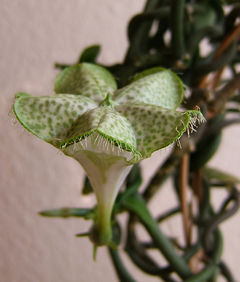- Ceropegia sandersonii
-
Ceropegia sandersonii 
Ceropegia sandersonii Scientific classification Kingdom: Plantae Division: Magnoliophyta Class: Magnoliopsida Order: Gentianales Family: Apocynaceae Genus: Ceropegia Species: C. sandersonii Binomial name Ceropegia sandersonii
Decne. ex Hook.f.Ceropegia sandersonii is a flowering plant in the genus Ceropegia (Apocynaceae), native to Mozambique, South Africa, and Swaziland. Common names are Parachute plant, Fountain flower, and Umbrella plant.
Ceropegia sandersonii is a prostrate, slender twinner, nearly hairless, with sparse, succulent leaves. The roots form narrowly fusiform clusters. The distinctive greenish white funnel-shaped (having a corolla-tube) flowers are 5–7 cm long and are placed on a delicate stalk. Due the fact that the corolla lobes are partially fused, the opening of the flowers is partially inhibited. The tips of the petals do not separate and form a roof or umbrella-like dome on the flower, while the fused bottom forms the tube. The openings between the petals are also referred to as windows, hence the name windowed flowers that is also used for flowers of this type (Weberling, 1992). The flower itself serves as a biological myiophilous (fly-pollinated) pitfall-trap, that traps flies when they descent into the corolla tube. Small hairs that are pointed downwards prevent the insect from escaping. Once trapped, the victim is thoroughly pollinated and only released when the flower is left off and the hairs weaken.
References
- Pooley, E. (1998). A Field Guide to Wild Flowers Kwazulu-Natal and the Eastern Region. Natal Flora Publications Trust, Durban.
- Focko Weberling (Author), R. J. Pankhurst (Translator) (1992). Morphology of Flowers and Inflorescences. Cambridge University Press; New edition edition.
Categories:
Wikimedia Foundation. 2010.
